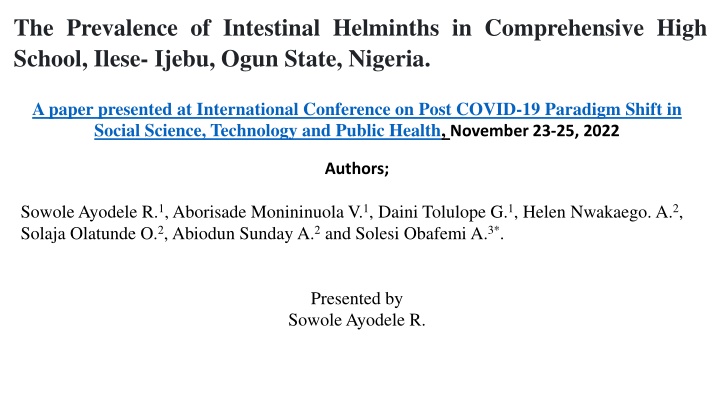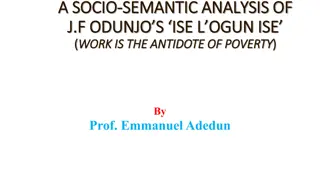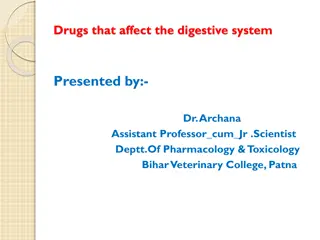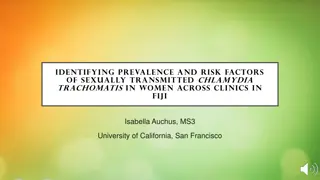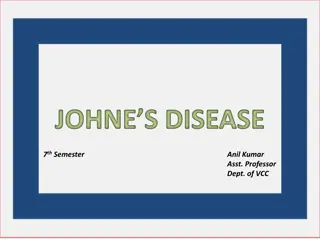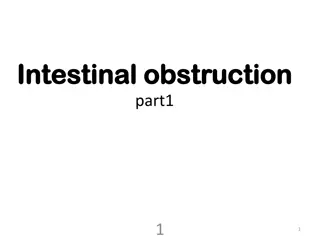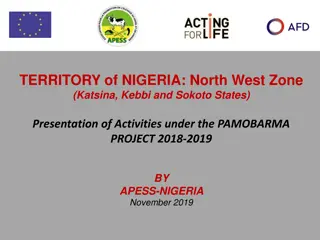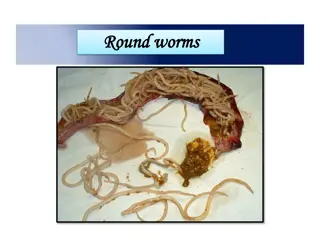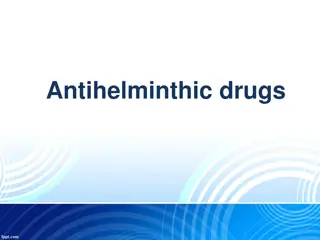Prevalence of Intestinal Helminths in Comprehensive High School, Ilese-Ijebu, Ogun State, Nigeria
Infestation by intestinal helminths poses a significant public health issue, impacting school-age children with chronic anaemia, growth stunting, malnutrition, fatigue, and cognitive impairments. The study aims to investigate the prevalence of intestinal helminths in a Comprehensive High School in Ilese-Ijebu, Ogun State, Nigeria, with a population of 10,000. The common parasites studied include roundworm, hookworm, and whipworm, affecting millions globally. Variations in prevalence and distribution call for immediate interventions in affected areas.
Uploaded on Oct 04, 2024 | 1 Views
Download Presentation

Please find below an Image/Link to download the presentation.
The content on the website is provided AS IS for your information and personal use only. It may not be sold, licensed, or shared on other websites without obtaining consent from the author.If you encounter any issues during the download, it is possible that the publisher has removed the file from their server.
You are allowed to download the files provided on this website for personal or commercial use, subject to the condition that they are used lawfully. All files are the property of their respective owners.
The content on the website is provided AS IS for your information and personal use only. It may not be sold, licensed, or shared on other websites without obtaining consent from the author.
E N D
Presentation Transcript
The Prevalence of Intestinal Helminths in Comprehensive High School, Ilese- Ijebu, Ogun State, Nigeria. A paper presented at International Conference on Post COVID-19 Paradigm Shift in Social Science, Technology and Public Health, November 23-25, 2022 Authors; Sowole Ayodele R.1, Aborisade Monininuola V.1, Daini Tolulope G.1, Helen Nwakaego. A.2, Solaja Olatunde O.2, Abiodun Sunday A.2 and Solesi Obafemi A.3*. Presented by Sowole Ayodele R.
Presentation outline: 1. Introduction 2. Method 3. Results and Discussion 4. Conclusion
1. Introduction Infestation by intestinal helminths is a major public health problem which causes chronic inflammatory disorders such as chronic anaemia, growth stunting, protein-calorie malnutrition, fatigue, poor cognitive performance, reduced long- term survival, diminished physical fitness and school attendance in school-age children1, 2.
The most common intestinal parasites within the group of helminths are STHs, including Ascaris lumbricoides (roundworm), Necator americanus and Ancylostoma duodenale (hookworm), and Trichuris trichiura (whipworm), have been considered to infect over a thousandth of million people, and much more are at risk of infections3, 4, 5. World Health Organization pointed out that more than a quarter of a million preschool children and over half a billion school-going children reside where the parasitic infection is common and immediate interventions are necessary9.
The prevalence and distribution of intestinal helminths vary from place to place in any population10. Hence, this cross-sectional survey is to study the Prevalence of Intestinal Helminths in Comprehensive High Schools, in Ilese- Ijebu, Ogun State, Nigeria. It has an estimated population of 10. 000 according to the 2006 population census. The predominant occupation is farming and trading. The borehole is their source of water.
2.Methods 2.1 Study area The project work was carried out at Comprehensive High School. Ilese- Ijebu. Ilcse- Ijebu, Ijebu- Ode, Ogun State. Ilese- Ijebu is a town founded after Ijebu- Ode along the old Benin Expressway. Ogun State College of Health Technology can be used to locate the town Ilese- Ijebu. Ilese Ijebu is under Atan town, the headquarters of Ijebu North-East Local Government in Ogun Slate. Nigeria.
2.2 Materials Sterile Universal bottles, Applicator sticks, Microscope slides, Coverslip, Normal saline, LugoPs Iodine and Microscope. 2.3 Sample collection Well-labelled Sterile Universal bottles were given to Fifty (50) students of Comprehensive High School, Ilese- Ijebu to put about 5gm of stool they defecated. 2.4 Sample analysis Macroscopic and microscopic examinations of stool were done to reveal intestinal parasites in the stool sample collected following the standard operating procedures (SOPs) as recommended by the WHO11.
3. Results and discussion The results of the study showed that out of 74 (74%) female -students' stool examined 22 (29%) students had intestinal helminths and, the 26 male (s) students accounted for 9 (34%), making a total of 31%) students were being infected. The parasites' distribution was thus as follows: Ascaris lumbricoides (round worm) was 48%; Ancylostoma duodenale (Hookworm) 17%; Strongyloides stercoralis (Threadworm) 13%; Taenia species (tapeworm) 22% respectively.
TABLE 1: Age of participants selected for intestinal helminthes Age(Years) Number Number of Infected % Infected Number not Infected % Not Infected Examined 11-12 13-14 15-16 17-18 Total 44 28 17 11 100 10 10 7 4 31 22.73 35.71 41.18 36.36 34 18 10 7 69 77.27 64.29 58.82 63.64
Table 2: Sex of participants selected for intestinal helminths Infection MALE FEMAL E TOTAL Age (year) No examined No infected % Infected No examined No infected % infected Total Infected % infected 11-12 8 3 33.33 36 7 31.82 10 32.26 13-14 7 3 33.33 21 7 31.82 10 32.26 15-16 6 2 22.22 11 5 22.73 7 22.58 17-18 5 1 11.11 6 3 13.63 4 12.90 Total 26 9 99.99 74 22 100.00 31 100.00
Table 3: The distribution of helminths on participants Age (year) Ascaris lumbricoides Hooworm Strongyloides stercoralis Taenia species 11-12 4 2 2 2 13-14 5 2 2 1 15-16 4 1 1 1 17-18 2 0 0 2 Total 15 5 5 6
Discussion From the results obtained 31% prevalence of intestinal parasite (helminth) infection among students of Comprehensive High School, Ilese- Ijebu was recorded which was higher than that recorded from a Previous study in Babile town of overall prevalence of intestinal helminthiasis to 27.2%10. The prevalence of hookworm infection was highest in the lowlands (24%) followed by the temperate (15%) and highlands (7%). The notable differences in the studies are explained by changings in geography, socio-economic conditions, and cultural practices of the population under consideration.
References 1. Lone R, Syed K, Lone A. (2011). Recent patterns and risk factors of intestinal helminthes infection among school children in Kashmir, India. Arch Clin Microbiol; 2 (3):2. 2. Uneke C. (2011). Soil transmitted helminth infections and schistosomiasis in school age children in sub-Saharan Africa: efficacy of chemotherapeutic intervention since World Health Assembly Resolution 2001. Tanzan J Health Res. 12(1):86 99. doi: 10.4314/thrb.v12i1.56366. 3. Hotez PJ, Bundy DAP, Beegle K, Brooker S, Drake L, de Silva N, Montresor A, Engels D, Jukes M, Chitsulo L et al. (2006). Helminth Infections: Soil-transmitted Helminth Infections and Schistosomiasis (Chapter 24). Disease Control Priorities in Developing Countries. In: Jamison DT, Breman JG, Measham AR, Alleyne G, Claeson M, Evans DB, Jha P, Mills A, Musgrove P. Editors. Washington (DC): The International Bank of Reconstruction and Development/The World Bank. New York: Oxford University Press. 4. Pullan RL, Brooker SJ. (2012). The global limits and population at risk of soil-transmitted helminth infections in 2010. Parasit Vectors.5:81. 5. Pullan RL, Smith JL, Jasrasaria R, Brooker SJ. (2014). Global numbers of infection and disease burden of soil transmitted helminth infections in 2010. Parasit Vectors.7:37. 6. Brooker S, Hotez PJ, Bundy DA (2010). The global atlas of helminth infection: mapping the way forward in neglected tropical disease control. PLoS Negl Trop Dis. 4(7):e779. 7. Girum Tadesse (2005). The prevalence of intestinal helminthic infections and associated risk factors among school children in Babile town, eastern Ethiopia.Ethiop.J.Health Dev. 19 (2). 8. World Health Organization. (2019). Bench aids for the diagnosis of intestinal parasites: World Health Organization.
Thank you For attention
